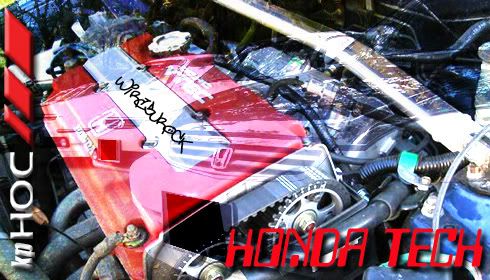Latest News
Translators
Honda NSX in Excess
Honda's randy looking NSX can only be called a SuperCar. In standard form its 3.2 litre all-alloy V6 punches out 206kW and the sophisticated suspension and mid-mount engine design fits the traditional sports car formula perfectly. But slip a couple of turbos between the rear wheels and a SuperCar just got super-er! No longer does it compete in the Supra RZ category; it's now hot on the heels of Marranello's finest.

And that's where Australia's Advanced Vehicle Operations (AVO) steps into the limelight. Initially, they twin turbo'd the car using the standard engine internals and low boost pressure, but the simple seduction of tuning up the boost soon saw the limits of the standard pistons...
Then it was time to get serious. Presented with the task of getting around 550hp, AVO responded with a bullet-proof engine build and one of the most well engineered 'one-offs' we've ever seen. The Honda V6 has been split open and re-built with a set of American-sourced forged pistons that provide a more turbo-friendly compression ratio of 9.1:1 - down from the factory's 10.2:1. The bottom-end remains near standard, keeping Honda's factory titanium rods but with specially made ARP rod bolts. Terry Wilson of AVO enthused about the strength and design features of the Honda engine, saying it's incredibly well balanced and uses such features as main bearing girdle strengthening all ex-factory.
While the heads were off, they received some minor cleaning up before being filled with Competition Cams stiffer valve springs. Stock camshaft profiles were kept to maintain the engine's amazing driveability. The other changes made to engine mechanicals include a 7 Bar (100psi) high-volume oil pump and a modified water-cooling system with custom header tanks.
Fabricating a pair of exhaust manifolds was an exercise in compact packaging. These labour intensive custom three-into-one tubular headers channel gases into the turbines, while short length twin 3 inch pipes and an AVO muffler are used post-turbo. Each of the Garrett-based '320hp' ball-bearing turbos delivers around 10psi boost into individual AVO air-to-air intercoolers, mounted proud behind the custom Lexan rear window. Getting air to flow through the cores took some ingenuity - you can't just stick them out the front when you've got a mid-engined car (not without 3 miles of plumbing anyway!).

Fuel and spark come courtesy of the Honda ECU, which has been augmented with an in-house AVO extra injector driver and six extra injectors mounted one near each intake port. This system works very well and the engine also benefits slightly from the cooling effect of the fuel being injected into the intake runners. The engine dines on a minimum fuel grade of premium unleaded, but will be seeing Elf race fuel very soon - we'll let you know why later! Because the standard ECU remains in place, the stock rev limit is still imposed at around 8000rpm - it's the turbo-torque which enables the big hp numbers to be produced.

 Backing the alloy V6 is the standard NSX 5-speed manual gearbox. It's been filled with stronger NSX-R gears plus a 40% higher clamping force pressure plate with a twin plate clutch. The factory limited slip diff copped a reworking too, with AVO strengthening and modified it to nearly the lock-up stage.
Backing the alloy V6 is the standard NSX 5-speed manual gearbox. It's been filled with stronger NSX-R gears plus a 40% higher clamping force pressure plate with a twin plate clutch. The factory limited slip diff copped a reworking too, with AVO strengthening and modified it to nearly the lock-up stage.Racetrack ready, the 1200-odd kg car is now suspended by fully adjustable Mugen front and rear dampers and Mugen springs. Stock anti-roll bars are still fitted. The car's handling is just mind-blowing. Turn-in is crisp and precise and the car's exit attitude can be easily throttle controlled with the hit of around 550hp! With the car's estimated 320km/h terminal speed, the braking department was brought up to spec with pizza-dish sized 13.5 inch Brembos with four-pot squeezers. Cameron says there's absolutely no fade and the overall braking performance is totally unlike any other car he's been in.
Spark Plug
Posted by vtek
on
Wednesday, July 7, 2010
, under
honda tech
|
comments (0)
1. Installing spark plugs
Torque is one of the most critical aspects of spark plug installation.Torque directly affects the spark plugs' ability to transfer heat out of the combustion chamber. A spark plug that is under-torqued will not be fully seated on the cylinder head, hence heat transfer will be slowed. This will tend to elevate combustion chamber temperatures to unsafe levels, and pre-ignition and detonation will usually follow. Serious engine damage is not far behind.
An over-torqued spark plug can suffer from severe stress to the Metal Shell which in turn can distort the spark plug's inner gas seals or even cause a hairline fracture to the spark plug's insulator...in either case, heat transfer can again be slowed and the above mentioned conditions can occur.The spark plug holes must always be cleaned prior to installation, otherwise you may be torquing against dirt or debris and the spark plug may actually end up under-torqued, even though your torque wrench says otherwise. Of course, you should only install spark plugs in a cool engine, because metal expands when its hot and installation may prove difficult.
2. Gapping
Since the gap size has a direct affect on the spark plugs' tip temperature and on the voltage necessary to ionize(light) the air/fuel mixture, careful attention is required. While it is a popular misconception that plugs are pre-gapped from the factory, the fact remains that the gap must be adjusted for the vehicle that the spark plug is intended for.Those with modified engines must remember that a modified engine with higher compression or forced induction will typically require a smaller gap settings (to ensure ignitability in these denser air/fuel mixtures). As a rule, the more power you are making, the smaller the gap you will need.
A spark plug's voltage requirement is directly proportionate to the gap size. The larger the gap, the more voltage is needed to bridge the gap. Most experienced tuners know that opening gaps up to present a larger spark to the air/fuel mixture, maximizing burn efficiency. It is for this reason that most racers add high power ignition systemsthe added power allows them to open the gap yet still provide a strong spark.With this mind, many think the larger the gap the better. In fact, some aftermarket ignition systems boast that their systems can tolerate gaps that are extremebe wary of such claims. In most cases, the largest gap you can run may still be smaller than you think.
3. Indexing "For racers only!"
Indexing refers to a process whereby auxiliary washers of varying thickness are placed under the spark plug's shoulder so that when the spark plug is tightened, the gap will pointed in the desired direction.
However, without running an engine on a dyno, it is impossible to gauge which type of indexing works best in your engine...while most engines like the spark plug's gap open to the intake valve, there are still other combinations that make more power with the gap pointed toward the exhaust valve.
In any case, engines with indexed spark plugs will typically make only a few more horsepower, typically less than 1% of total engine output...for a 500hp engine, you'd be lucky to get 5hp...while there are exceptions, the bottom line is that without a dyno, gauging success will be difficult.
4. Heat Range selection
Let's make this really simple: when you need your engine to run a little cooler, run a colder plug. When you need your engine to run a little hotter, run a hotter spark plug. However, NGK strongly cautions people that going to a hotter spark plug can sometimes mask a serious symptom of another problem that can lead to engine damage. Be very careful with heat rangesseek professional guidance if you are unsure.
With modified engines (those engines that have increased their compression), more heat is a by-product of the added power that normally comes with increased compression. In short, select one heat range colder for every 75-100 hp you add, or when you significantly raise compression. Also remember to retard the timing a little and to increase fuel enrichment and octane. These tips are critical when adding forced induction (turbos, superchargers or Nitrous kits), and failure to address ALL of these areas will virtually guarantee engine damage.An engine that has poor oil control can sometimes mask the symptom temporarily by running a slightly hotter spark plug. While this is a "Band-Aid" approach, it is one of the only examples of when and why one would select a hotter spark plug.
5. Using "racing" spark plugs
Be cautious!! In reality, most "racing" spark plugs are just colder heat ranges of the street versions of the street spark plug...they don't provide any more voltage to the spark plug tip!! Their internal construction is no different (in NGK's case, as all of our spark plugs must conform to the same level of quality controls) than most standard spark plugs. There are some exceptions, though. Extremely high compression cars or those running exotic fuels will have different spark plug requirements and hence NGK makes spark plugs that are well-suited for these requirements...they are classified as "specialized spark plugs for racing applications". Some are built with precious metal alloy tips for greater durability of for their ability to fire in denser or leaner air/fuel mixtures.
However, installing the same spark plugs Kenny Bernstein uses in his 300+mph Top Fuel car (running Nitromethane at a 2:1 air/fuel ratio and over 20:1 dynamic compression) in your basically stock Honda Civic (running 15:1 a/f ratios with roughly 9.5:1 compression) will do nothing for you!! In fact, since Kenny's plugs are fully 4 heat ranges colder, they'd foul out in your Honda in just a few minutes. NGK as a company tries to stay clear of saying that a racing spark plug (or ANY spark plug) will give you large gains in horsepower...while certain spark plugs are better suited to certain applications (and we're happy to counsel you in the right direction) we try to tell people that are looking to "screw in" some cheap horsepower that, in most cases, spark plugs are not the answer.
To be blunt, when experienced tuners build race motors, they select their spark plugs for different reasons: to remove heat more efficiently, provide sufficient spark to completely light all the air/fuel mixture, and to survive the added stresses placed upon a high performance engine's spark plugs, and to achieve optimum piston-to-plug clearance. Some of these "specialized racing plugs" are made with precious metal alloy center/ground electrodes or fine wire tips or retracted-nose insulators...again, these features do not necessarily mean that the spark plug will allow the engine to make more power, but these features are what allow the spark plug to survive in these tortuous conditions....most racers know screwing in a new set of spark plugs will not magically "unlock" hidden horsepower.
6. Using high power ignition systems
Many of the more popular aftermarket ignition systems are of the capacitive discharge type. They store voltage, or accumulate it, until a point at which a trigger signal allows release of this more powerful spark. Companies like Mallory, MSD, Crane and Accel, to name a few, offer such systems.
They affect spark plugs in that they allow the gaps to be opened up to take advantage of the increased capacity. The theory is that the larger and the more intense the spark you are able to present to the air/fuel mixture, the more likely you will be to burn more fuel, and hence the more power you will make.Only use on modified or older non-computer controlled vehicles.
In reality, computer controlled vehicles do such a good job of lighting off the air/fuel mixture (as evidence by the ultra-low emissions), added ignition capacity would do little to burn more fuel since the stock configuration is doing such a good job. Older non-computer controlled vehicles or those that have been modified with higher compression or boosted (nitrous, turbo, supercharged) engines can certainly take advantage of a more powerful ignition system.

















